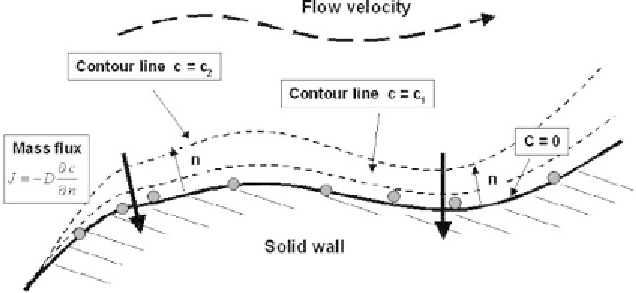Biomedical Engineering Reference
In-Depth Information
Figure 6.5
Sketch of transport of concentration in the real case where
D
¹
0.
¶
c
�
(6.10)
+
U c D c
.
Ñ =
D +
S
t
¶
where
S
is the source term. The terms
S
in the advection-diffusion equation is a
source or sink term depending of its sign. The unit of
S
in the International Unit
System is mole/m
3
is or particles/m
3
/s.
S
may be a function depending on a volume, a surface, a contour, or a point.
Usually creation or removal of concentration of a constituent is linked to chemical
or biochemical reactions. In Chapter 7, we shall see some examples of source or
sink terms.
6.2.3 Boundary Conditions
Many different forms of boundary conditions (BC) can exist for the advection-
diffusion equation. However, two boundary conditions are remarkable.
The first one is the Dirichlet condition
c
= 0 at a solid wall. This condition
means that the concentration of the studied macromolecules or nanoparticles van-
ishes at the solid wall. This is the case of total adhesion, when any particle of the
concentration field that contacts the wall is immobilized and removed from the
ensemble of the transported particles (Figure 6.6).
Figure 6.6
Dirichlet condition at a solid wall. Contour plot of concentration and mass flux. The
particles are immobilized on the wall upon contact. A boundary layer of concentration develops
along the solid wall.


















































